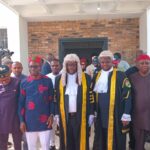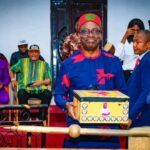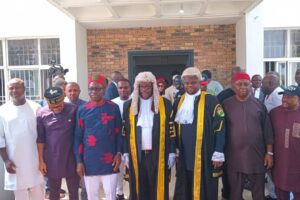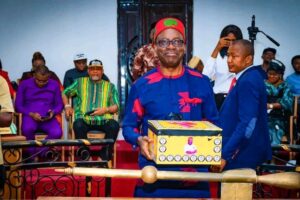Mambilla elders warn against fulanis lands seizures
…. says Enough is enough of the territorial expansion
A sound of warning by the Elders of Mambilla, Sardauna Local Government Area of Taraba was said to be timely and a warning signal to advert a looming crisis through a statement made available to this medium.
In a join statement core signed by Elders and vanguards of Mambilla, Hamanjoda Gitaru Nyiwa and Modibbo Yusufu Yerimaru on behalf of Elders and Mambilla Communities worldwide chronicled how the Fulani have marauded their land and going unchecked by the supposed government of the Taraba state that is ought to play a good role in managing the situation.
Their statement gave out details of historic attempts of Fulani to take over what they called their land of inheritance and ancestrally belonging to them not the Fulanis.
The Statement is a hit debate over Maisamari, Ngoroje and Kamkam and other communities to carve out and cede out as Fulanis territory.
The community leaders fingered out a close friend of Governor Ishaku Dickson Darius of Taraba State of working hard to thwart and change the course of history.
Wondering and asking why the government of Taraba state are playing with the fragile peace being enjoyed by the people, depriving the entire people of Sardauna local government the right of true ownership of their ancestral lands.
These and many more is being reiterated in the statement by the Mambilla people who envisaged and gave sounds of warning to the current leaders in Taraba state to employ Justice in all their dealings as the only way peaceful coexistence can be ensured.
The statement captured their views in full, read the details.
Being Press Statement by Mambilla Elders on the Fulani Attempt to Further Expropriate Mambilla Ancestral Lands and Expand Their Land Grabs on The Mambilla Plateau through another Commission of Inquiry
Ladies and Gentlemen of the Fourth Estate of the Realm,
We have been jolted as a Community by some alarming developments regarding our ancestral lands on the Mambilla Plateau and are compelled to issue this statement. As you all know, another Judicial Commission of Inquiry again upon a recent one was set up by H.E the Executive Governor of Taraba State, Arch. Darius Dickson Ishaku, on 7th February 2022 under the chairmanship of His Lordship, Justice Joel Agya, with Barr. Kimamra Maigida as Secretary, specifically and solely to ascertain whether Maisamari is under Nguroje or Kamkam Chiefdom. His Excellency while inaugurating the committee was quoted to have said, ”newly inaugurated committee to determine the real status of Maisamari and its environs has become necessary so as to avoid any unpleasant issue that will arise from such area. He further said that the general public to remain calm and carry on their normal duties as he is on his toe that those responsible for causing unrest will not be allowed to see the light of the day”. Was he speaking for the other side? Since he has found the “real status” of Maisamari in two previous occasions through a Commission and a Committee? We have wondered.
We can recall that after the Nuhu Adi Commission, another administrative Panel was set up by the Governor himself which reported her findings coinciding with the Nuhu Adi Commission’s report, which both implicitly and explicitly defined Maisamari as part of the historical Kamkam territory. The Governor restated this fact at a meeting on the subject and questioned why after asking for “only Nguroje Town”, his closest personal friend was tactically attempting to expand to some other areas. Why would the Governor want another (third) investigation on the same matter when he had two previous reports on the same status of Maisamari? A Judicial Commission of Inquiry and an administrative Committee had both investigated and reported to him. This third attempt, pushed forth by the close friend, is obviously an attempt to rubbish the two earlier investigations. If we are looking for a third “real status”, what do we call the previous two? We are suspicious of these endless investigations, especially as so much anti-Mambilla hate comments in the last few years have come from that criss-crossing figure claiming to be the best ally and his associates.
We are alarmed by the undisguised, post- and prejudicial plan of Government to find another “real status of Maisamari and its environs”, which gives the obvious impression that despite two previous reports, the current status of Maisamari as part of Kamkam Chiefdom is not “real” and the “real” is still being sought through a third report on the same issue. We are all aware that this status has recently been settled by a long and painstaking investigation and findings of the Hon. Justice Nuhu S. Adi Judicial Commission of Inquiry in the recent 2017. What then made it “become necessary” to review the Nuhu Adi Commission and another committee findings and recommendations? We are aware that a certain overbearing Fulani spearhead in Government, credited with the remote and proximal causation of most socio-political crisis in the area and in governance generally, has openly voiced his intention to overturn the Justice Nuhu Adi Commission findings and upset the applecart. Indeed, he worked hard to scuttle the Justice Adi Commission report. We are not oblivious of all subterranean moves made by the same person since that utterance. We are aware of the man’s lies and constant deception of the Powers, including his false alarm to the Governor that the safety of his tea farm at Benena (Maisamari) cannot be guaranteed if he left it under Mambilla control. And so the Mambilla Nation is put up for sale on this basis. We can recall the undisguised statement of a certain Fulani figure in the 1990s to the effect that they would do all in their power to carve out a “Mbororo kingdom” on Mambilla soil. Little did we know that it would be insidiously introduced using the apparatus of the State Government and then expanded by degrees over our ancestral lands. It is now first Maisamari, but they have other areas too in their long-term plan. We are aware of the destabilizations going on in Kuma Chiefdom next door, Kabri, Gembu, Mbamnga and Kaka. Again, Barup District of Kamkam and several others are targeted for dismemberment, but a committee is sought to rubberstamp it. They are denied a peaceful coexistence. On the other hand, total protection of Nguroje’s peace has been ensured and not even a ward head has had any sleepless nights there. We also know that the Fulani ultimate interest is to takeover the entire land of our ancestors from us, having begun first as “only inside Nguroje”, and next to use the powers that be to expand to the rest of Mambilla. We wish to state that this new “another commission upon commission” is thought out in bad faith and intended to satisfy a vested interest as aforestated. Besides, the Governor’s statement has prejudiced the findings the “another commission” might wish to make since he has implied that the current situation is not “real”.
The Justice Nuhu S. Adi Commission Judicial Commission of Inquiry was set up by this very Governor, H.E D.D Ishaku, in June 2017 under the Chairmanship of His Lordship, Justice Nuhu S. Adi, which submitted her Report in November 2017, recommending the creation of Kamkam alongside four other Chiefdoms (Mbamnga, Kuma, Kabri, Kaka) as the result of findings and evidence available to them as stated in paragraph 16, page 71, vol. 4 of the Report of Hon. Justice Nuhu S. Adi Judicial Commission of Inquiry into the Communal Crisis in parts of Sardauna Local Government Area of Taraba State, The Justice Nuhu Adi Judicial Commission of Inquiry of 2017 stated as follows;
“That from the evidence and findings, the Commission recommends the ancient four (4) independent Mambilla Chiefdoms that existed prior to the colonial rule be restored to 3rd class Chief status, and also one Kaka chiefdom of 3rd class status namely: Kabri, Mbamnga, Kamkam, Kuma, Kaka”.
The Taraba State Local Government Law 2000, the Taraba State Upgradement of Traditional Rulers and Creation of Districts (Order) 2018, by virtue of Order 4(1) and Schedule 1, upgraded Kamkam to 3rd Class Chiefdom status and appropriately placed Maisamari as a District of Kamkam Chiefdom in keeping with the history the Mambilla Plateau. The entire Mambilla nation celebrated the Upgradement of the four ancient Mambilla Chiefdoms of the plateau to Third-Class Chiefdoms and commended the Government for this action. However, taking advantage of certain developments in the State, certain politicians hurried to stampede the Governor into destroying this good work of his. On the other hand, Nguroje chiefdom sprang out of nowhere. It was NOT one of the ancient chiefdoms of the Plateau; in fact, it is historically a district of the ancient Kamkam Chiefdom ascertained by the Nuhu Adi Commission and not a separate territory. It was NOT among the chiefdoms recommended by the Judicial Commission of Inquiry for Upgradement to Third-Class status, but rather emerged by the intrigues of some “political friendship” of certain politicians. Nguroje Fulani settlement was a later emergence as a cattle selling point that attracted settlers not indigenous to the Mambilla Plateau. Its settler community sits on Kamkam territory and sprang from the cattle business and not some indigenous nativity as to warrant the establishment of a “settler chiefdom”. Chiefdoms are a result of a people’s ancient nationality and indigeneity. The idea of “settler chiefdom” is strange and unknown in Nigeria and Africa. You cannot establish a foreign chiefdom on a local territory and upon a pre-existing autochthonous community. That is in itself inflammatory. As severally stated by the Gbong Gwom of Jos and others, you cannot establish a chiefdom, which is an entity defining nativity, on other unrelated people’s land. “Nguroje” is itself a property of the Mbungnu or Kamkam people. It has always been a part of the Kamkam territory and the establishment of cattle market, business, and new town does not change that status. Indeed, it was planned by the British to be returned to the jurisdiction Chief of Kamkam where it rightly belongs. .
The question is again, why the setting up of another Judicial Commission of Inquiry? Coming on the heels of another Commission of Inquiry? Why another “real status” for Maisamari after an earlier real status findings by the Justice Nuhu Adi Judicial Commission of Inquiry? Is it meant to rubbish the earlier Report or to investigate the integrity of the previous Commission? Or does political interest warrant the forfeiture of the posterity of an entire nation? We have no option but to seriously and most passionately ask questions. From the terms of reference of the suspicious “third inquiry” on the same subject matter, it is clear that the report of the new commission has already been pre-fabricated and the Commission is a mere window-dressing and subterfuge for land seizures already mooted. We know as a fact that the Governor has his tea factory at Maisamari; he is a politician and has political loyalists who equally have interests and have voiced their intention to sway Government along inordinate paths in this regard. We assert that, Maisamari’s status has historically never been in any doubt, because, stemming from the last Commission Report and His Excellency’s Order passed by the House of Assembly in 2018, it is a Law in Taraba State made according to the history of the Mambilla Plateau, and doing anything to the contrary will amount to official inconsistencies. There is no doubt that throughout the history of the Mambilla Plateau all Western Mambilla i.e. Kamkam (Mbungnu) area has been a single unit, whose headquarters is currently Kakara (Mbanden) and this status has not changed.
The history of the area reveals that the entire area of ancient Mbungnu (Kamkam), from Benena (“Maisamari”) in the north-western end to Takam, Damu, Chamvurr (“Gurgu”), to old Mbungnu (“Nguroje”), Mbanden (Kakara), Magu (present-day Zongon- Ajiya), Ndunda, Furu (Yerimaru), Zima (Bangoba), Ndu (Kasalasa), and virtually the entire Western and Northwestern Mambilla areas were first inhabited by the Mbungnu since the distant pre-colonial times. From the reign of Mbon Wa at Benena (Maisamari) the first capital of the Mbungnu, to the several other apex rulers of Mbungnu after the movement of the capital to Mbungnu (Nguroje), Nguung (Kusuku) down to Mbanden (Kakara), the rulership of all Western Mambilla (including the many other villages) remained with the Mbungnu Dynasty down to European rule. Throughput British rule and after, the Mbungnu Headquarters and Chiefs remained unperturbed. The word “Nguroje” is derived from the Fulani term “Ngurore”, meaning, “old settlement”, in reference to Old settlement of the Mbungnu. The word “Kamkam” was introduced for Mbungnu area in colonial times. Chamvurr (“Gurgu”), named after its founder, was established in later times by Chamvurr, a Mambilla man of Tep origin. He had first settled east of this village and relocated o here as the trade route opened. Chamvurr limped as he had a leg defect on one of his legs, and Hausa traders referred to him as “Gurgu”, the limping man. To date, Gurgu or Chamvurr is predominantly Mambilla in its population. They too have no desire to be “seized” by their newer neighbours.
Evidence from various archaeological studies have revealed that the Mambilla Plateau has been peopled by inhabitants of the same culture for nearly 5 millennia The first Fulani slave raids of relatively recent times(1890s), after the declaration Germany suzerainty in the region in July 1884, met the Mbungnu people long settled here. There were four major raids from Banyo. The defeat and killing of the greatest Fulani slave raid leader from Banyo, namely, Lamdo Usumanu of Banyo in the Battle of Kamattan, by the combined Mambilla Homeland Defence Warriors in 1893, however, dashed the hopes of Fulanis ever thinking of occupying Mambilla and Mambilla remained independent despite the raids until practical European rule. The Fulani neither settled nor grazed in Mambilla until after the British takeover. This is attested to by various neutral and unbiased historians and colonial administrators, including W.H Paul (1939) and Rehfisch (in a 1956/60 essay). The Banyo Lamidate concedes that Usumanu “died” in 1893 in a publication of theirs of which we are privy to. His grave is still marked in the Mambilla Village of Libo (Ribao) now separated by the new boundary. Failing in their attempts “to induce a definite migration of Fulanis to Mambilla”(1935)and failing to attract Fulani graziers to Mambilla in the initial stages due to the menace of lions, the British lamented, “it was a case of man [the British] proposing and lions disposing” (1937).The Fulani entrance into Mambilla was, to all intents and purposes, a British inducement for economic reasons (cattle tax, dairy and beef interests).
Fulani fictions about a pre-colonial Fulani administration in Mambilla has been contradicted and faulted by every other report. The British, just as the Mambilla, acknowledged that there were slave raids on the Mambilla Plateau, from about 1890 during nominal German suzerainty, but found no evidence of a “Fulani conquest” or “administration” in Mambilla in pre-British times. According to the Resident, Adamawa Province, C.O Migeod (July 1921), no such conquest of the Mambilla Plateau took place. Resident Migeod quickly faulted the Gashaka Fulani claim that two chieftainates, Kuma and Titong, had come under their influence. The Resident stated in his Report, that although Kuma and Kerke (Titong) suffered from Fulani raids in pre-British (actually German) times, “they have always maintained their independence”.
There is no denying that there were formerly no other inhabitants beside the Mambilla in this territory down to the advent of the German colonial masters. As late as 1933 under the British, only one tribe was acknowledged by the British to occupy the Mambilla Plateau, the Kaka immigration being still insignificant then. Fulani graziers were isolated, seasonal visitors deterred by the then widespread lions population. According to a British Intelligence Report, as much as stated by other colonial reports:
On 12 January 1937, the British stated, “Until after the [First World] War, there was no settlement at all of Fulani on the [Mambilla] Plateau”; and 31st December 1937, they repeated, “No Fulani settled on the Mambilla Plateau until after the British occupation”. They repeated this in several other reports, just as they repeatedly rebutted the Fulani story of conquests on the Mambilla.
By the 1890s, Old Mbungnu Village (also known as “Nguroje” today) was a key Mbungnu settlement. Mbon Sibo, a memorable chief at Old Mbungnu (“Nguroje”) was a descendant of his predecessor, Mbon Wa at Benena (Maisamari).After the death of Mbon Sibo (then Chief of Old Mbungnu, now “Nguroje”), Mambon Sewa moved the headquarters to the more fertile Nguung (Kusuku) in about 1882. Tradition here rejects the story given the British by Fulani informants that Old Mbungnu was virtually conquered and the population driven out. Tradition insists that the shift in location of the capital was determined by economic (farming) interests and not a “driving out”. How would they have resettled at Ngùung which was a stone’s throw from Old Mbungnu if indeed that was the fact? Mbon Sokom, Mbon Burim, Mbon Siwuru and their successors reigned after Mambon Sewa from then to this very day as Chiefs of the Western Mambilla Chiefdom of Kamkam. According to an account prepared by Alh. Abubakar Bobboi Jauro, Alh. Suleiman Zubeiru, Hon. Emmanuel Q. Njiwa, Alh. Idris Waziri, Mr. K.M Adda, Alh. Hammanjoda Gashaka and Alh. Suleiman Titong; and published 1983 during the Staff Presentation Ceremony in honour of a former Chief of Mambilla, Muhammadu Salori Mansur (para. 3):
“The inhabitants of the present day Kakara and Magu were said to be the early settlers of the present site of Nguroje (settlement) which today is mostly inhabited by the Hausa/Fulani Communities”. It is why the British proposed the return of Old Mbungnu (“Nguroje”) to the jurisdiction of the Kamkam Chief whose property it was.
Going down the history of Mambilla Chieftaincy, Mbungnu was among the Thirty Chieftainships recognized by the Germans between 1906 and 1915. The Germans lost the Area in the First World War (1914-1918) and Mambilla was made part of the League of Nations Mandated Territory (later, UN Trust Territory). The League of Nations entrusted the entire Mambilla area to the British after the World War I. The British introduced certain administrative changes to the German system. It was the British who brought Mambilla and Adamawa face-to-face, in the same Province, and for the first time the two incompatible peoples wriggled in the same administration. The history of this forced marriage has remained a sad commentary in the pages of African history. In the British indirect rule, Adamawa elements who could read and write reports in Arabic or scrap English (for translation in Yola) began to be sent to Mambilla for the first time in history for administrative tasks on behalf of the British administration. According to C.K Meek (1931), apart from the British administration, that is, before the British advent, the Mambilla had nothing to do with Adamawa and Gashaka.
The Adamawa Native Authority of the British-made province sent the first of these three “pro-consuls” in the person of Marafa Muhammadu in 1935 under the auspices of the British colonial administration. Marafa had never known or seen Mambilla. He was a total carpetbagger. According to the British, the Mambilla did NOT accord Marafa a warm welcome to Mambilla when he arrived. The headquarters of the then British local administration had been moved to Mayo Ndaga in 1933 by an order of the then Resident, following a decision reached at the December 1932 Provincial Conference held at Toungo, while the British administration excised Kurmi (Kentu) and merged it with Wukari (later returned to Mambilla Division).. Gashaka village was adjudged “unhealthy” then, while Mambilla provided the temperate climate desired by the British. Marafa arrived in 1935 to meet the headquarters already in Mayo Ndaga on the Mambilla Plateau. The second of the foreign proconsuls was Dan-Lawan Dahiru (1940-1952). The last of the three non-native administrators was Usman Mukaddas (1953-1959). All three were dismissed from their jobs by the British for maladministration and oppressive treatment of the Mambilla population. It was under Marafa that attempts began be made to carve out Mambilla lands for Fulani possession; and according to a British Intelligence Report, the Fulanis were responsible for more than half of the administrative difficulties encountered in Mambilla owing to their continual plots and intrigues in the area. Under the repressive Adamawa headship of Mukaddas, the Mambilla decided to shake off foreign rule unjustifiably foisted on them by the British indirect rule system through Adamawa Province. Accordingly, the Mambilla voted against the Nigerian Federation in the 1959 plebiscite to rid themselves of the Fulani menace in their area. Following recommendations by the Panel, Mukaddas was virtually driven out of Mambilla in December 1959 as a result of Mambilla protests and he fled back to Yola as the Premier’s order for his removal was hot and urgent, made in order to convince the Mambilla Nation to choose to remain in Nigeria. Premier Sir Ahmadu Bello promised the Mambilla and similarly dispossessed communities that no external element would be imposed in their Area any longer; and that was the condition under which the Mambilla agreed to join the Nigerian Federation. Thus, the former German district of Mambilla became a Nigeria territory on just one condition: that no Fulani hegemony would be imposed on them any longer. This must not be returned through the backdoor in 2022. This promise has been violated since then with the intention of foisting Fulani control and suppressive antics on the people of the Mambilla Plateau. Attempts to seize more Mambilla territories for Fulani occupation or settlement have been made severally, but these have often been vigorously resisted.
Back to 1926 upon their advent, the British collapsed the Thirty Mambilla Chieftainates into ten and Mbungnu (Kamkam) was again among the Ten Chieftainates (see list of the Izard Chiefs) recognized by the British in 1926 and re-labelled “Village Areas” in the British system. The British introduced the title of “Village Heads” for the Chiefs. The Ten Chieftaincies were: Mbungnu (Kamkam), Warwar (Mvurr), Vakude (Gam), Kabri (Ndik), Mbamnga (Liimila), Bang, Tamnya (Bogor, Mbug), Gembu (Bommi) and Titong (Kerke). All Chieftainates then were Mambilla Chieftainates as there were not yet any significant entrance of non-Mambilla people into the Mambilla Plateau. This remained the scenario until February 2018 when non-Mambilla chiefdoms were created in the area out of the existing Mambilla Chiefdom. It must be noted that apart from Kamkam (Mbungnu) Chieftainate, there was no other Chieftaincy in the entire Western Mambilla throughout history. The Kaka groups of Antere and Inkiri, who moved up northwards across the River Donga into the Mambilla Plateau from Mfumte district in Cameroon settled within Mbungnu jurisdiction and were accordingly initially placed under the administration of the Kamkam Chief. Kakara (Mbanden) was the headquarters of the entire Western Mambilla where the “Village Heads” (Chief and subordinates) of Western Mambilla Area (including the ward head of Old Mbungnu) met to discuss the affairs of the area. The other Sub-Native Authorities represented by the Regional Courts were Mbamnga, Kabri, Kuma and the central Gembu Courts.
In 1962, the Native Courts (Jurisdictions and Powers) Notice, NNLN No. 65 of 1962, re-affirmed the establishment of the Court in Kakara, headquarters of Western Mambilla. These Courts were a sort of Sub-native administrations, many of which have today become Local Government head quarters in the area of the former Adamawa provinces. Indeed, the four main chieftainates were proposed as regional sub-native authorities with a Central Administration. This status of Kakara as headquarters of all Western Mambilla was again re-affirmed in the Northern Nigerian Native Courts (Jurisdiction and Powers) Notice of 2 March 1967. In 1968, the Area Courts Edict of the North-Eastern State of Nigeria Gazette, No. 5, Vol. 2 1968 abolished the Chiefs Courts and replaced them with Judge-led courts where judges presided over the Courts. The Court and Chiefs Assembly continued in Kakara for all Western Mambilla. Much later in 1975, an attempt was made by an area Court Judge who was newly transferred to Kakara to “steal” the Court by moving it to Nguroje (Old Mbungnu). Consequently, a complaint was lodged and an Order was made by the then North-Eastern State Government that the Court be immediately returned to Kakara. Thus, the Court was returned to Kakara, the headquarters of the entire Western Mambilla Area in keeping with the history of the Area. Alongside the Kamkam Chiefdom under the British were Liimila (Mbamnga) for the entire Southern Mambilla, Kuma for the entire Northern Mambilla and Ndik (Kabri) for the entire Eastern Mambilla. Bommi (Gembu) retained the central administration from 1947. The then Gongola State in 1981, created Kamkam District with Headquarter in Kakara by virtue of the Gongola State Local Government Law 1977 (Amendment) Law No. 5 of 1981. This was in continued recognition of the status of Kakara as the Headquarters of Western Mambilla. In 2003, Kamkam Chiefdom was the only new chiefdom created from the then existing singular Mambilla Chiefdom. However, a strange attempt to change the Headquarters from Kakara to Nguroje (Old Mbungnu) was resisted, culminating in a serious disagreement and the process was thus aborted.
Finally in 2017, the Report of the Hon. Justice Nuhu S. Adi Judicial Commission of Inquiry into the Communal Crisis inParts of Sardauna Local Government Area of Taraba State in June, 2017, Vol. 4, Main Report: Findings and Recommendations, p. 17 at para. 16 stated as follows:
“That from the evidence and findings, the Commission recommends the ancient four (4) independent Mambilla Chiefdoms that existed prior to the colonial rule be restored to 3rd Class status and also one Kaka Chiefdom of 3rd class; namely Kabri, Mbamnga, Kamkam, Kuma and Kaka”.
In accordance with the Justice Nuhu Adi Commission findings and recommendations, the Taraba State Government upgraded the ancient Western Mambilla Chieftainate of pre-colonial and early colonial times (alongside the other three former regional sub-councils) to a Third-Class status. However, the Government also created a formerly unknown and unhistorical “Nguroje”, initially defined as “requested by certain Fulani politicians as a chiefdom only for, and coextensive with, Nguroje town”, as another chiefdom in Western Mambilla within Kamkam territory and made equal in status with Kamkam Chiefdom. This split the ancient Kamkam territory into two and handed over the Old Mbungnu Town (Nguroje) to the immigrant community. From hindsight, “Nguroje” arose after the original Old Mbungnu Town as a Hausa kola trade stopover camp after the German stint, and largely in about the 1920s, then subsequently as a cattle trade centre after the British establishment of a cattle market here. The earliest non-Mambilla settlers and ward heads here were itinerant Hausa traders, such as Musa from Bichi near Kano in 1932, and not Fulani who immigrated later than the Hausas. There were initially no Fulani in Nguroje, and Hausa traders established make-shift huts here as a staging post for trekking to Banso (Panso) kola markets in Cameroon. Today, the new and unhistorical “Nguroje Chiefdom” created to satisfy certain Fulani associates and foisted on Kamkam soil, intends to swallow up the Mambilla Chiefdoms beside Kamkam. Their plot to expand from Nguroje to “capture” the entire Mambilla Plateau through the backdoor has been recently loudly proclaimed by certain Fulani arrowheads and known to other people. They want to expand Nguroje, which they initially requested and stated to exist “only inside Nguroje Town”, by taking over Maisamari District of Kamkam Chiefdom from Kamkam. We do not know which District and Chiefdom is next in the destabilization and balkanization plot. It is, however, certain that Kamkam and Kuma Chiefdoms are under a real and present threat of the Fulani expansionism as the plot to expand the Fulani hegemony all over the historical Mambilla territory has been well orchestrated by the Fulani elements in the Taraba Government. This in defiance of the findings and the recommendations contained in the Hon. Justice Nuhu S. Adi Report at paragraph 34. p.75 vol. 4, which stated as follows:
“The above are the honest findings and recommendations of the Judicial Commission of Inquiry set up by His Excellency, the State Governor Arch. Darius Dickson Ishaku, to investigate the communal crisis in parts of Sardauna Local Government Area of Taraba State in June. 2017 and to the best of our ability, knowledge and belief we have played our small part in bringing about lasting peace on the Mambilla Plateau, hope and pray that Government will passionately consider these submissions and implement accordingly”.
This entire effort is under threat and a return to disharmony and chaos is threatened by the machinations, intrigues and shenanigans represented by the attempt to expand Nguroje into non-Nguroje areas. We are well aware of the bargain between the Fulani spearhead and a House Member to trade Maisamari and other some other districts he too wants to snatch from Kamkam. The connivance will ultimately rubbish the Governor’s good intentions of 2018. These unending attempts to destabilize the Mambilla chiefdoms are unhealthy. What remains unknown is whether the Governor himself knows this or just nodding to anything from the man. In view of the forgoing, we do not know the criterion by which the Taraba State Government awarded Nguroje with the 3rd-Class Chiefdom right here in Kamkam territory on a platter of gold. Old Mbungnu (Nguroje) is Kamkam territory and we have never decided to sell it. It is not justice to create a settler chiefdom on Kamkam territory. No matter the length of private or public friendship with any Fulani figure, we do not think that the future of a nation should be toyed with; especially as a previous second Committee after the Nuhu Adi Commission had reported the same thing as captured by the Nuhu Adi Commission. His Excellency the Governor has just set up another Judicial Commission of Inquiry, a third attempt, with the aim of expanding the Jurisdiction of Nguroje Chiefdom. This would be the third committee on the same subject matter after the earlier two. The question in the lip of everyone now is, after Maisamari, which District is next, since Kamkam (and rumoured Kuma) Chiefdom have the initial threat? The Mambilla Community is the most peaceful Community in the entire Mambilla Plateau and are law-abiding citizens. Conflicts only arise with the emergence of attempts to seize Mambilla lands or upon the importation of armed mercenaries to decimate the Mambilla population. Otherwise, not a fly can be harmed in Mambilla. We intend to explore all peaceful means to safeguard Mambilla lands from continued Fulani grabs and dispossession as has been observed in certain previous incidences.
We wish to note that several Fulani elements in Government since Gongola State to the current Taraba have acted in bad faith in always pushing governments to act maliciously in matters affecting the Mambilla and their ancestral lands. There is a long catalogue in this regard. The current plot to carve out more Mambilla lands for Fulani occupation is part of the long violation of the desire of the Mambilla since the plebiscites to be free from external control in their area and it is eternally unacceptable. We urge the Government to retrace its step and shun the pressure from certain Fulani in the Taraba Government and outside it to stampede it into carving out Mambilla lands for Fulani occupation and rubbishing its commendable work of 2018. Politics and traditional governance and land ownership must not be indiscriminately muddled. We the Mambilla owe no one our historical and ancestral territory.
Right now, there is already an extreme situation of land dispossession and undue land grabs. A study undertaken by an expatriate investigator in 1998 revealed that in some areas of the Mambilla Plateau, the Fulani immigrants have cornered 78% of the land formerly owned by the indigenous Mambilla:
“The uncontrolled growth of livestock has been followed by high competition for land between the graziers (who are recent immigrants) and those Mambilla farmers who survived the [British-aided] Fulani occupation. The graziers holding most of the political power have progressively deprived the farmers of their lands: the latter are now confined within isolated small enclaves. They have lost their economic independence and are reduced to work for the graziers or to emigrate to Cameroon. Furthermore, in a large part of the Mambilla Plateau, the pastoral range has been divided between the graziers, excluding the Mambilla farmers … from land ownership and enhancing their dependency on graziers. Such an explosive situation is illustrated by two surveys of the Kuma and Leme (Nge) regions. Over 78 sq. km studied in Kuma, the Mambilla possess only 22% of the area; the survey found 132 herds (at an estimated total of 9,475 cattle) with a population density of 1.5 cattle per hectare, almost totally owned by Moslem graziers. The area studied in Leme (Nge) covers 113.5 sq. km of uneven land. Although confined to nine enclaves, the Mambilla owned 32% of the land, while Moslem graziers possess 67%. 145 herds have been counted (at an estimated total of 10, 215 cattle): 63% owned by Mbororo, 20% by Fulani and Hausa … 10% by Mambilla and 7% by the recent Yamba (Kaka) immigrants.”(Hurault, Jean M (1998), “Land Crisis on the Mambilla Plateau of Nigeria, West Africa”. Journal of Biogeography, vol. 25, No. 2, March, 1998, pp. 285-299. © 2009 Blackwell Publishing Ltd. Online 9 December 2009.
and Dendo (supra) have a similar account of Anglo-Fulani activities in the Mambilla area:
“The slave trade ceased [under British administration] but the dominance of the Fulbe was maintained [really, brought about] because of lack of effective supervision by the colonial authorities. Even when permanent authority was established, the colonial policy of boosting the authority of Islamic elites meant that the administration of justice remained in their hands. One result of this has been three quarters of a century [since the British advent] of bad relations between the two groups [Mambilla and Fulani]”. (Blench, R.M & Dendo, M (2005), Conflict and Cooperation: Fulbe Relations with the Mambilla and Samba People. Anthropology, 2, 1984. 29 December 2005 edition. http://lucy.kent.ac.uk/dz. Kay Williamson Educational Foundation, 8, Guest Road, Cambridge).
This was re-echoed in the findings of the Taraba Legislature in 1992 and the investigation of an independent newsmagazine, TSM, of 14th June that year. Ocheorome Nnanna reported (pp. 6 -11) that the situation was such that the inhabitants had to seek permission from their new-found neighbours in order to get any space to dig graves to bury their dead parents on their own land! Contacted by the Magazine, the then Council Chairman lamented:
“(This is) a replay of the South African apartheid scenario where the owners of the land have been turned into tenants and vassals to a new settler group who have seized everything”.
The Magazine continued,
“Yola Fulanis, who were wealthier, more educated and sophisticated than the other minorities of the surrounding areas [of Adamawa Province] seized the opportunity to introduce their traditional feudalism all over the place including temperate Mambilla Plateau… Only Fulani judges were sent up the Mambilla. Together with corrupt, subservient policemen and selfish local indigenes, the Plateau was virtually handed over to Fulani through the certificate of occupancy introduction”.
And while the courts were crowded with land cases in which the Mambilla battled one another for the little land allowed them by the immigrant community, the Fulbe watched on with laughter. The corrupt judges fell over each other to get a posting to Mambilla where there were many court cases and where they could enrich themselves through bribes. They dispossessed the people, and made the crime another source of their wealth. They were judges in the bid to redress their own wrongs!
The Speaker of the Taraba Legislature by 1992, Rt. Hon. (Barr) Anthony Damburam, told newsmen after a visit to Mambilla that the situation in 1992 was still the same as obtained under colonialism in the past:
“There is no doubt that if you go on to the Mambilla Plateau, you will notice a clear difference between the down-trodden and their overlords. The farmers usually belong to the former … The cattle rearers belong to the latter group … yet they are in the minority. Obviously, something is seriously wrong and must be corrected now”.
Certainly, we strongly believe that Government should act appropriately to redress massive land dispossessions through equitable land redistribution and not perpetuate further seizures herself. Government must curb this political hatred which seeks to spiral into a conflagration that may spare no one in the end.
The unjustifiable land dispossessions have been on for too long. The new method of expanding this dastardly programme by gradual expansion of Fulani hegemony is unacceptable. We believe that the peaceful disposition of the Mambilla is a virtue and not a defect. It must not be misunderstood for something else. We may remind that the figure who criss-crossed Yola, Bauchi, Bakundi, Cameroon, etc with kolanuts in the run up to the 2002 invasion is still well-known and fresh in our memory. We the Mambilla Community pursue peaceful coexistence at all times and reject in totality any attempt, directly or indirectly to satisfy Fulani land-grabbing instincts under whatever subterfuge. We reject the surreptitious creation and tactical expansion of the unhistorical “nativity” designed to steal lands of our ancestors. Political disagreements should not be translated into land seizures to take an imaginary pound of flesh. We the vast majority of Mambilla have no connection with political interests and His Excellency did tell us at Government House that he meant well for us. That his anger was directed at particular persons only. Now, why at everyone? What went wrong that this anger after all was to be unleashed on everyone Mambilla? We know that all Mambilla Chiefdoms are severely destabilized from the Mbonduaship to the Ward Headships, and attempts are made to break them up, while the “only-begotten” Fulani area of Nguroje has been well protected from the storm unleashed on all Mambilla Chiefdoms. We are alarmed by certain developments. Impeccable sources quoted the Governor as denying that the deliberate destabilization and attempts at dismemberment of the Mambilla Chiefdoms was the handiwork of some few politicians from the Mambilla Plateau (and we need no crystal ball to know them anyway), and that he was not behind the many criminal acts perpetuated against these chiefdoms. We watched on. Current events are certainly revealing a deep-seated ethnic hate programme.
We therefore call on the Taraba State Government to end this unending land seizures and dispossessions. Government should address herself to the comprehensive Report and findings of her own Commission of Inquiry, the Justice Nuhu S. Adi Judicial Commission of Inquiry of the recent 2017, and of the subsequent Committee, and avoid rubbishing her good works under the pressure of any “adviser” that could open a cankerworm of intractable fallouts from the inordinate political interests. This new “commission with a singular mission” should be recalled and demobilized in the interest of all. In fact, members of this new Commission should think twice before accepting a dark yeoman’s and hatchet man’s job that may foreclose an otherwise sterling reputation of theirs.
Sgd.
Elders and Vanguards,
1. Hamanjoda Gitaru Nyiwa
2. Modibbo Yusufu Yerimaru
For all Elders and Mambilla Communities Worldwide












Add Comment